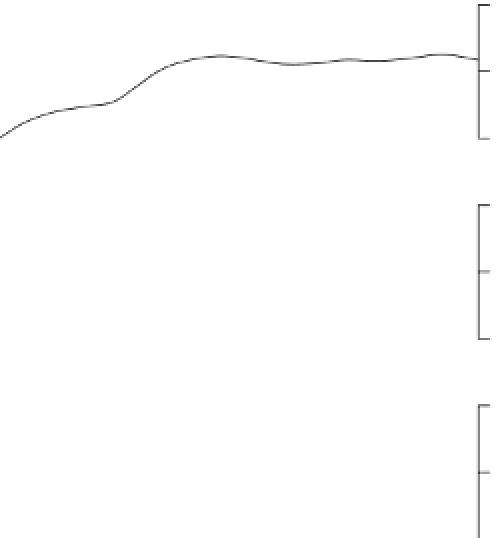Geology Reference
In-Depth Information
(cf. p. 299). They are begun by wave erosion, overwash,
a lack of aeolian deposition, or deflation of vegetation or
poorly vegetated areas. Once started, they are enlarged
by wind scour and slumping, and avalanching on the
sidewalls.
Estuaries
Estuaries
are tidal inlets, often long and narrow inlets,
that stretch across a coastal alluvial plain or run inwards
along a river to the highest point reached by the tide.
They are partially enclosed but connected to the open
sea. They are transition zones between rivers and the sea
in which fresh river water mixes with salty ocean water.
Early in their evolution, their shape is determined by
coastal topography, but this changes fairly rapidly as sed-
iment erosion and deposition reach a steady state. Many
are young features formed in valleys that were carved out
during the last glacial stage and then drowned by rising
sea levels during the Holocene epoch. Figure 13.16 is a
physiographic classification due to Rhodes W. Fairbridge
(1980). Figure 13.17 shows an alternative estuary clas-
sification based upon the mixing of river water with
seawater.
Figure 13.13
Formation of a chenier plain.
Source:
Adapted from Hoyt (1969)
Tidal flats, salt marshes, and mangals
Currents associated with tides carry copious amounts of
sediment inside areas of shallow water. The ebb and flow
of tidal currents fashions a range of coastal landforms.
on cliff tops. Coastal dunes are similar to desert dunes,
but the foredune (the first dune formed behind the beach)
is a prominent feature resulting from the interaction of
nearshore processes, wind, sediments, and vegetation.
Coastal dunes are mainly composed of medium-sized
to fine quartz grains that are well to very well sorted,
but calcium carbonate is common in warm tropical and
mediterranean regions. They are found in a range of
environments (Carter
et al
. 1990) (Figure 13.14). The
largest dune systems occur in mid-latitudes, behind high-
energy to intermediate wave-energy coasts and facing
the prevailing and dominant westerly winds. Dunes also
develop on east-facing swell and trade-wind coasts, but
they are less common and smaller in polar and tropical
regions. The occurrence and nature of coastal dunes are
the outcome of a set of interacting factors (Box 13.2).
Blowouts
are shallow, saucer-shaped depressions or
deep and elongated troughs occurring in dune fields
Tidal flats
Tidal flats
are banks of mud or sand that are exposed at
low tide. They are not actually flat but slope very gently
towards the sea from the high-tide level down to a little
below the low-tide level. Three basic units may be iden-
tified in tidal flats: the
high-tide flat
(a gently sloping
surface that is partly submerged at high tide); the
inter-
tidal slope
(a steeper but still gently inclined zone lying
between the high-tide flat and the lower tidal limit); and
the
subtidal slope
, which is submerged even at low tide
(Figure 13.18).
Tidal flats end at the edge of the sea or in major
tidal channels
, the floors of which lie below the lowest



























































